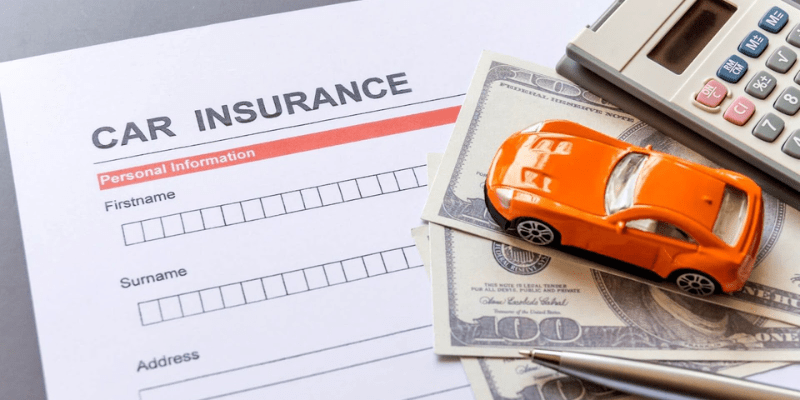In the intricate world of personal finance and investment, every decision,, plays a pivotal role in achieving long-term financial freedom. For many, a vehicle represents a significant investment, often acquired through financing. A common question that arises for these prudent investors is: can I get liability insurance on a financed car? This inquiry delves deeper than mere compliance; it touches upon risk management, asset protection, and the foundational principles of responsible financial stewardship. Today, Mnewso will accompany you to explore the critical nuances surrounding vehicle insurance for financed cars, helping you navigate the requirements and make informed choices that align with your broader financial objectives. Understanding these dynamics is essential for protecting your valuable assets and ensuring your financial well-being.
The fundamental role of liability insurance

Liability insurance stands as the bedrock of any responsible automotive insurance strategy, designed primarily to protect you. This crucial coverage typically comprises two main components: bodily injury liability and property damage liability. Bodily injury liability covers medical expenses, lost wages, and pain and suffering for those injured in an accident you cause. Property damage liability, conversely, pays for repairs or replacement of another person’s vehicle or property damaged in the incident. Without adequate liability coverage, a single accident could expose your personal assets to substantial legal claims, potentially jeopardizing your entire financial plan. It is a non-negotiable component of driving legally in most jurisdictions and a critical consideration when assessing your financial risk profile.
Lender requirements for financed vehicles
When you finance a car, you enter into a contractual agreement with a lender who retains a financial interest in the vehicle until the loan is fully repaid. This arrangement inherently means the car serves as collateral for the loan. To safeguard their investment, lenders universally impose specific insurance requirements that extend well beyond basic liability coverage. The answer to whether can I get liability insurance on a financed car without additional coverage is typically no, as lenders demand comprehensive protection. They require borrowers to maintain full coverage insurance throughout the loan term, which includes both collision and comprehensive coverage in addition to the standard liability policy. This mandate ensures that if the vehicle is damaged, stolen, or totaled, the lender’s financial stake is protected, allowing them to recover their losses. Failing to adhere to these stringent insurance stipulations can lead to severe consequences, potentially including the lender obtaining forced-place insurance at a significantly higher cost or even repossessing the vehicle.
Understanding lender mandates
Lender mandates are not arbitrary; they are a direct reflection of risk assessment in the financial sector. When a bank or credit union finances a car, they are essentially taking a bet on your ability to repay the loan and maintain the asset’s value. The requirement for full coverage insurance mitigates a substantial portion of this risk. It ensures that unforeseen events, such as accidents, natural disasters, or theft, do not leave the lender with a depreciated or non-existent asset against an outstanding loan balance. These mandates are clearly outlined in your loan agreement, often detailing minimum coverage limits for collision and comprehensive policies, sometimes specifying deductibles. It is imperative for borrowers to thoroughly review these terms to ensure compliance, underscoring the importance of understanding all aspects of your vehicle’s insurance.
Consequences of non-compliance
Ignoring a lender’s insurance requirements can lead to a cascade of undesirable financial repercussions. The most immediate consequence is often the imposition of “force-placed” or “collateral protection” insurance by the lender. This insurance is typically much more expensive than a policy you would purchase independently and offers coverage primarily for the lender’s interest, providing minimal to no protection for you, the borrower. The cost of this force-placed insurance is then added to your monthly loan payments, significantly increasing your financial burden. In more severe cases of prolonged non-compliance, lenders reserve the right to declare the loan in default, which can lead to the repossession of your vehicle. This not only results in the loss of your car but also inflicts significant damage to your credit score, making it harder to secure future loans or financing. Therefore, while you may inquire, “can I get liability insurance on a financed car,” the financial reality dictates a broader protective approach.
Beyond basic liability: Comprehensive and collision coverage

While answering the question, “can I get liability insurance on a financed car” is important, understanding the broader spectrum of coverage available is paramount, especially for financed vehicles. Beyond the foundational protection offered by liability insurance, comprehensive and collision coverages are indispensable components of a robust auto insurance policy, particularly when a third party has a financial interest in your vehicle. These two types of coverage address damages to your own vehicle, protecting your investment directly. Collision insurance covers the cost of repairing or replacing your car if it is damaged in an accident with another vehicle or object, regardless of fault. Comprehensive insurance, on the other hand, protects against a wider array of non-collision related incidents such as theft, vandalism, fire, natural disasters, and animal collisions. Together, these coverages form the “full coverage” typically mandated by lenders.
The role of collision insurance
Collision insurance is designed to provide financial protection for your vehicle in the event of an accident. It covers the costs associated with repairing or replacing your car if it collides with another vehicle, a stationary object like a tree or a pole, or even if it flips over. This coverage is crucial because accidents, unfortunately, are an unpredictable part of driving. Without collision insurance, even a minor fender-bender for which you are at fault could result in substantial out-of-pocket expenses for vehicle repairs, potentially derailing your personal financial plans. For financed vehicles, collision coverage is particularly critical as it ensures that the lender’s collateral is protected against damage incurred in an accident. The payout, safeguarding both your and the lender’s investment.
The importance of comprehensive insurance
Comprehensive insurance acts as a critical safety net against a myriad of perils not covered by collision or liability policies. This coverage extends to non-accident related damages and losses, offering protection. Consider a scenario where your car is stolen from your driveway or damaged by a hailstorm; comprehensive insurance would cover the repair or replacement costs, subject to your deductible. For a financed car, comprehensive coverage is just as vital as collision insurance, ensuring the vehicle’s value is protected against a broad spectrum of external threats. Lenders require this coverage because it shields their asset, providing an all-encompassing layer of protection for their investment.
Navigating insurance costs and factors
Understanding that your inquiry about, “can I get liability insurance on a financed car” invariably leads to the necessity of full coverage means you must also understand the factors influencing its cost. Car insurance premiums are not static; they are dynamically determined by a complex interplay of numerous variables, reflecting an individual’s risk profile and the specifics of their vehicle. For prudent investors, dissecting these factors is key to optimizing expenses while maintaining robust coverage. Geographic location, for instance, significantly impacts premiums due to varying rates of accidents, theft, and natural disasters, as well as state-specific insurance regulations. The type of vehicle you drive, including its make, model, age, and safety features, also plays a substantial role. High-performance or luxury vehicles often incur higher premiums due to their repair costs and increased theft risk, while vehicles with advanced safety systems may qualify for discounts.
Personal risk profile and driving history
Perhaps the most influential factors in determining insurance premiums are related to your personal risk profile and driving history. Insurers meticulously evaluate an applicant’s driving record, with a history of accidents, traffic violations, or DUIs invariably leading to significantly higher rates. A clean driving record, conversely, is a strong indicator of responsible behavior and often translates into lower premiums. Age and experience are also critical considerations; younger, less experienced drivers typically face higher rates due to statistical evidence of increased accident involvement. Credit history, in many states, also impacts insurance costs, as studies suggest a correlation between financial responsibility and driving behavior. Furthermore, how much you drive annually, your marital status, and even your occupation can subtly influence your premium, as they all contribute to an insurer’s assessment of your overall risk.
Deductibles and coverage limits
Strategic management of deductibles and coverage limits offers a tangible avenue for influencing your car insurance costs. The deductible is the out-of-pocket amount you agree to pay towards a claim before your insurance coverage kicks in. Opting for a higher deductible typically results in a lower monthly or annual premium, as you are assuming more financial risk. Conversely, a lower deductible means higher premiums but less out-of-pocket expense at the time of a claim. Carefully assess your emergency fund and risk tolerance when choosing a deductible. Coverage limits define the maximum amount your insurer will pay for a covered loss. While lenders specify minimum limits for financed vehicles, you have the flexibility to increase these limits for enhanced protection, especially for liability. Higher limits provide greater financial security against catastrophic claims but will also increase your premium. Balancing these two elements is essential for customizing a policy that meets both your financial capacity and risk exposure.
Strategic insurance choices for financial prudence

Making strategic insurance choices extends beyond merely meeting lender requirements, particularly for individuals focused on achieving financial freedom. It involves a holistic approach to risk management, integrating insurance decisions with broader investment strategies and financial goals. While the immediate concern might be, “can I get liability insurance on a financed car,” the long-term perspective dictates a more comprehensive understanding of how insurance contributes to wealth preservation and growth. Savvy investors recognize that underinsuring an asset like a vehicle can expose them to significant financial setbacks, eroding years of diligent saving and investment. Conversely, over-insuring with unnecessary coverages can lead to wasted premiums, diverting capital that could otherwise be invested or saved. The goal is to find the optimal balance that provides robust protection without undue financial strain, ensuring that your automotive assets are secured within the framework of your overall financial plan.
Bundling policies and seeking discounts
One of the most effective strategies for reducing insurance costs without compromising coverage is bundling your insurance policies. Many insurance providers offer significant discounts when you purchase multiple types of insurance—such as auto, home, and umbrella policies—, anti-theft devices, and even for paying your premium in full or setting up automatic payments. Some insurers offer discounts for low mileage drivers or for completing defensive driving courses. Regularly reviewing your policy with your agent and inquiring about all potential discounts can ensure you are not leaving money on the table.
Regular policy reviews and adjustments
The financial landscape and your personal circumstances are dynamic, necessitating regular reviews and adjustments to your insurance policies. What was adequate coverage a few years ago might not be suitable today. As your financial situation evolves, perhaps with increased assets or a growing family, your need for higher liability limits or different types of coverage might change. Similarly, as your car ages and depreciates, you might consider adjusting your collision and comprehensive deductibles or even dropping these coverages if the vehicle’s market value no longer justifies the premium cost. Major life events such as marriage, moving to a new area, or changes in employment should all trigger a policy review. Proactive engagement with your insurance provider, typically on an annual basis, ensures that your coverage remains aligned with your current needs, financial goals, and market rates, avoiding both underinsurance and unnecessary expenses.
Conclusion
Navigating the complexities of vehicle insurance, particularly when considering the question, “can I get liability insurance on a financed car,” underscores a fundamental principle of sound financial management: risk mitigation is paramount. As we’ve explored, while basic liability coverage is a legal necessity, financed vehicles invariably require a more robust insurance strategy encompassing collision and comprehensive policies. This full coverage not only protects your asset but, more importantly, safeguards the lender’s interest, ensuring the stability of your loan agreement. Mnewso encourages every investor to approach car insurance with the same diligence and strategic foresight applied to their investment portfolios. By understanding lender requirements, leveraging available discounts, and regularly reviewing your policies, you can optimize your coverage, control costs, and build a resilient financial foundation that supports your long-term wealth creation goals. Make informed decisions, protect your assets, and continue on your path to financial freedom.

